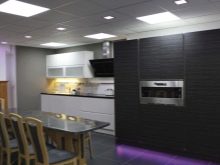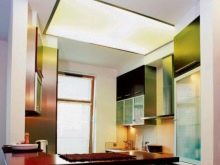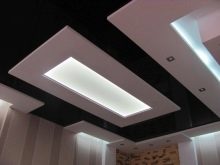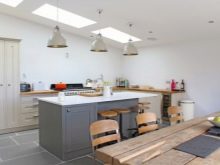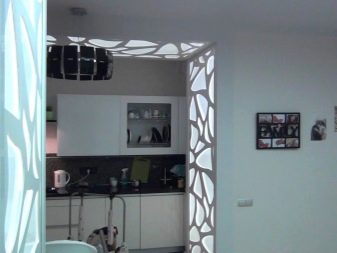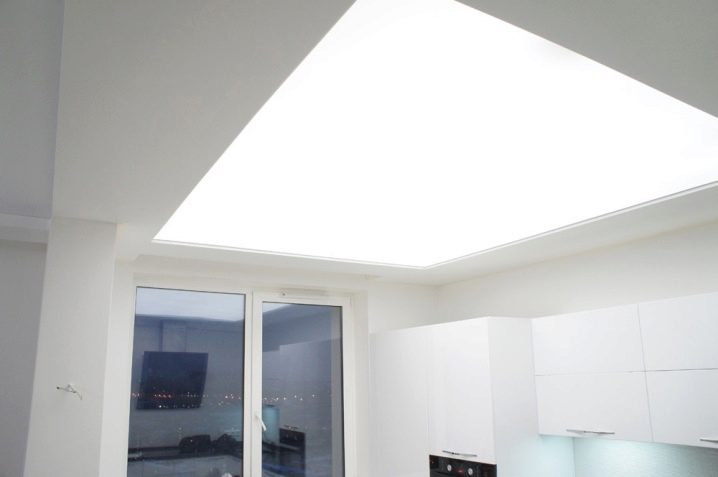Light panels on the ceiling: features and benefits
The use of light panels in interior design of various stylistic orientations is one of the modern trends. In addition to the excellent appearance, the panels can easily focus the light in the necessary areas without rooming the room with partitions. They can be used in both home and office / commercial sector, and the ease of installation and operation of the finished product only increase the popularity of light panels.
Special features
Light panels have a compact size and modern design. For lighting using LED elements. Light panels consist of several main components, connected in a convenient and practical design that provides ease of operation and ease of maintenance.
Light strips consist of several basic elements, which include:
- LED light source.The number of lamps depends on the size of the panel and the required light intensity;
- The body of the product consists of a translucent polymer that provides distinctive lighting. On the back wall there is a reflective film that amplifies and normalizes the glow, if there is a fault in one of the diodes;
- auxiliary electronics (transformer, stabilizer and others).
Advantages and disadvantages
The advantages of light panels on the ceiling include:
- Attractive design, featuring a wide choice of shapes and colors;
- You can order a panel of a suitable style and size, since their production is based on the use of ready-made LED lamps and does not have any particular difficulties;
- relatively small dimensions, when compared with equivalent power lighting devices, their thickness does not exceed 14 mm, which significantly saves space without lowering the ceilings;
- simple installation of the finished product allows the installation of such panels, even for people who do not understand the electricity;
- such products can create zoned lighting, highlighting the desired area.This option is often used for large rooms, studio apartments and rooms in which several people live together;
- pleasant lighting is provided by the ability to control the intensity of the panel through control drivers, it is also possible to change the color of the light from warm yellow to a cooler white
- high ratio of consumed and radiated energy - about 110 times due to the use of LED technology;
- long service life;
- LEDs are resistant to temperature changes;
- instant output at a given intensity of illumination;
- silent operation of light sources - LEDs;
- low temperature lamp operation;
- safe emission spectrum of LEDs, which determines their widespread use without the possibility of damage to people, animals and plants;
- made from environmentally friendly components without the use of toxic substances.
The disadvantages of LED lighting strips is their high cost, which is directly related to the price of LED lamps. In addition, the products are produced only in modern design, which may be inappropriate in some interior styles, for example, in the classics.
Kinds
Light panels are manufactured for specific operational needs, which determines their design features both in external design and in terms of filling products.
In form
Manufacturers offer a choice of different shapes and colors of enclosures. The most common options include:
- square (with average dimensions of 20–60 cm);
- round (diameter up to 24 cm);
- rectangular.
Under the order, manufacturers can make lamps of the desired shape, size and color.
By type of installation
Light panels are made with various types of fasteners, main species include:
- recessedwhich assume placement in a certain design, for example, plasterboard, wooden or other box;
- invoices options are attached directly to the surface of the ceiling, wall or other plane in the same way as a regular lamp on screws or other fastening means;
- suspended - from the ceiling fasteners, a suspension is made for cables, which allows you to create a clearly marked light zone, for example, you can select the dining table in the kitchen.
By the direction of light
The radiating elements in the light panels can be installed on a movable base, allowing you to adjust the direction of illumination. Depending on the direction of light products are divided into two types:
- with a constant directivity of the lamps;
- with interchangeable light vector.
By the presence of a diffusing coating
On the panels may be present or absent translucent coating, which determines the specific nature of the light flux. There are the following types of panels:
- with a diffusing element (shade), such lighting creates a pleasant and comfortable atmosphere, excellent for lighting recreation areas, eating and other places with similar characteristics;
- without it, direct light is more intense and can provide the necessary lighting when performing small and scrupulous actions, for example, in a jewelry or other store when considering small-sized goods, reading books, working with microelectronics and other options.
By the presence of regulatory controllers
The light panel can be equipped with a special device that regulates the intensity of illumination, and in some embodiments, and its color, in this case, all products are divided into the following types:
- with stable lighting;
- with adjustable light intensity;
- with regulation of intensity and color of lighting.
Use in the interior
When deciding on the purchase of light panels, you need to decide for what purpose they will be used: additional or main lighting. This factor affects their placement in the room. The place of attachment, in turn, determines the format of the product. So, light panels can be installed on such surfaces:
- ceiling;
- window;
- wall;
- partition;
- cornice;
- column.
In the case of a wall, ceiling or wall, the dimensions of the panel correspond to the dimensions of these planes. On the eaves and columns you need to install products of appropriate width, otherwise they will not fit into the interior, and also their fastening will be not entirely reliable and convenient.
Creating a basic lighting with light panels, products can be placed in different sequences relative to each other. For example, the location of each other, that is, lines with certain intervals, diagonally from each other - in a checkerboard pattern. You can combine panels of various shapes, for example, round and rectangular options to highlight different zones in the room.
Options for suspended and suspended ceilings
The versatility of products, their compact size and ease of use allow the use of light panels in conjunction with other elements of decorative interior decoration.
Like light panels, suspended ceilings are becoming increasingly popular due to the excellent appearance, combined with ease of installation and operation, which determines their frequent sharing. The light panel can be installed under the cover of a fabric suspended ceiling, although more often the lamp is installed in a carved niche of both a knitted and film stretch ceiling. The low temperature of the device ensures complete safety when close to PVC or fabric surface, does not spoil the appearance of the coating.
A wide range of designs for both light panels and stretch ceilings makes it possible to create interiors for every taste without the need for complicated expensive design repairs.
LED light panels are replacing fluorescent lamps in the presence of an Armstrong-type suspended ceiling, since the latter are inferior to the operational and aesthetic properties of diode devices.Installation of products is reduced to the choice of placement of illuminators relative to the entire area of the room, and replacing the panels of the suspended ceiling for lighting. If the dimensions of the light panels are smaller than the cells, they can be embedded in the slotted standard panels, which also does not cause much difficulty.
Installation of the ceiling box with light and LED-panels, see the video below.








